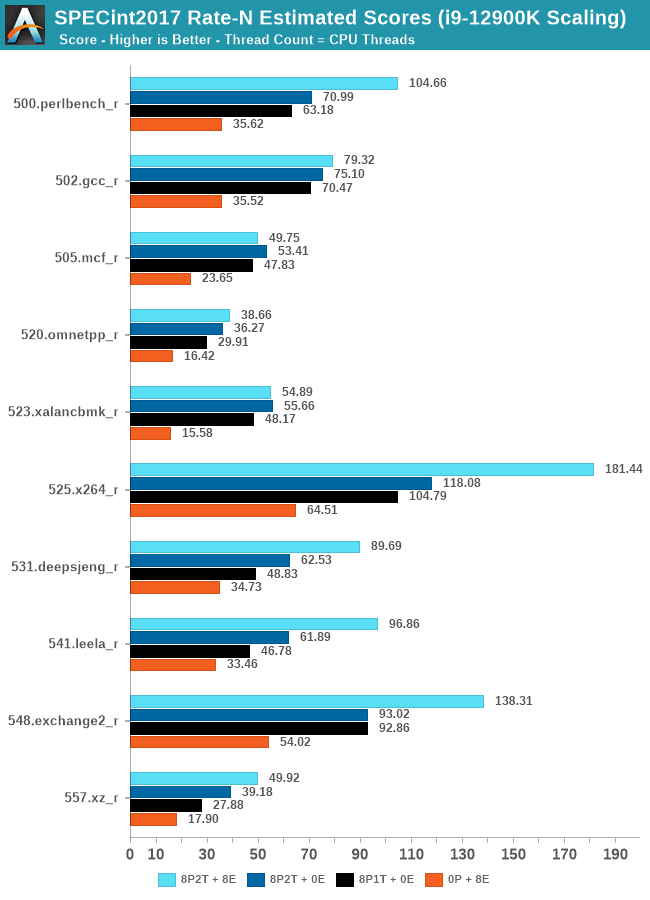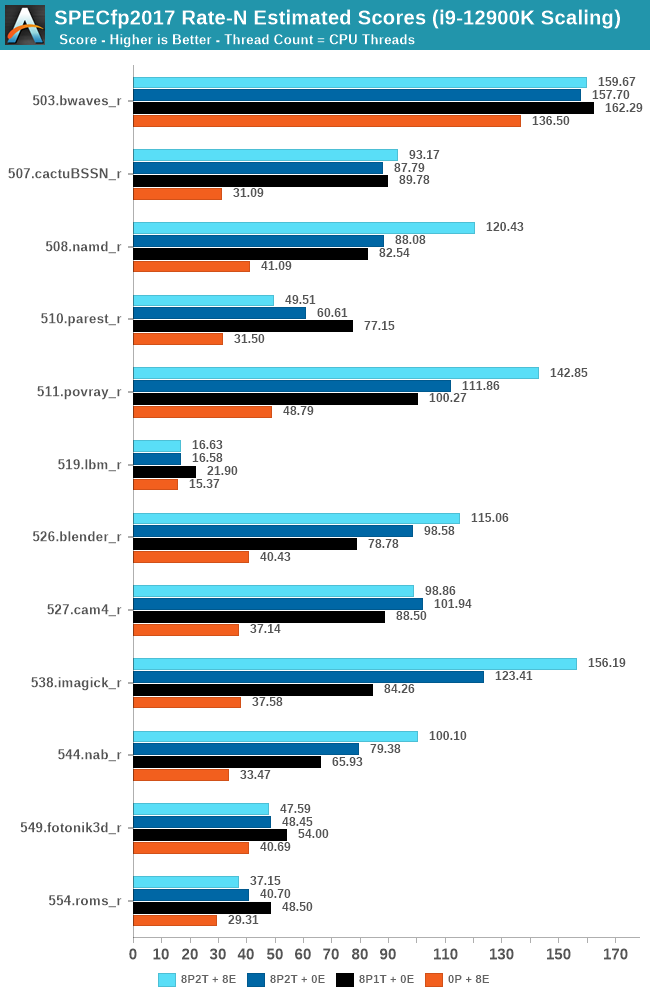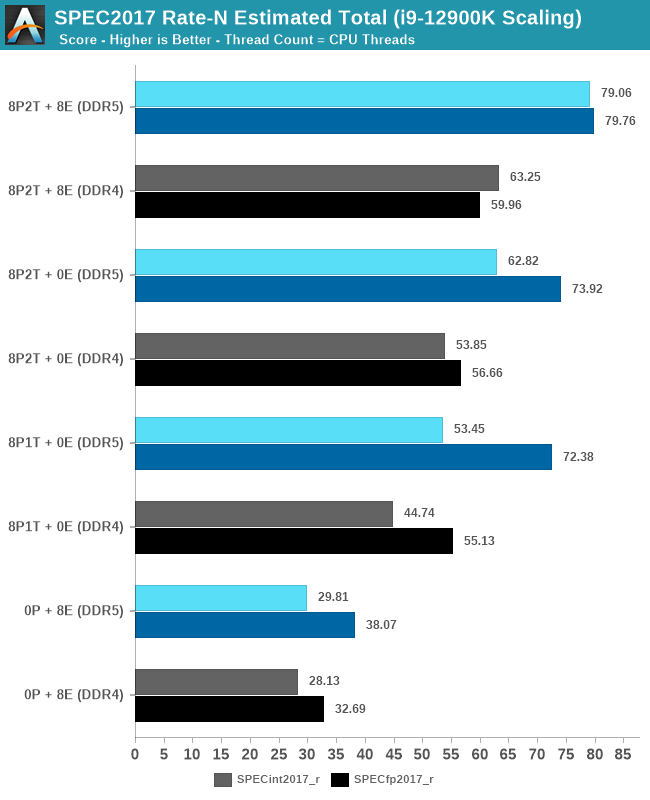The Intel 12th Gen Core i9-12900K Review: Hybrid Performance Brings Hybrid Complexity
by Dr. Ian Cutress & Andrei Frumusanu on November 4, 2021 9:00 AM ESTCPU Tests: SPEC MT Performance - P and E-Core Scaling
Update Nov 6th:
We’ve finished our MT breakdown for the platform, investigating the various combination of cores and memory configurations for Alder Lake and the i9-12900K. We're posting the detailed scores for the DDR5 results, following up the aggregate results for DDR4 as well.
The results here solely cover the i9-12900K and various combinations of MT performance, such as 8 E-cores, 8 P-cores with 1T as well as 2T, and the full 24T 8P2T+8E scenario. The results here were done on Linux due to easier way to set affinities to the various cores, and they’re not completely comparable to the WSL results on the previous page, however should be within small margins of error for most tests.

In the integer suite, the E-cores are quite powerful, reaching scores of around 50% of the 8P2T results, or more.
Many of the more core-bound workloads appear to very much enjoy just having more cores added to the suite, and these are also the workloads that have the largest gains in terms of gaining performance when we add 8 E-cores on top of the 8P2T results.
Workloads that are more cache-heavy, or rely on memory bandwidth, both shared resources on the chip, don’t scale too well at the top-end of things when adding the 8 E-cores. Most surprising to me was the 502.gcc_r result which barely saw any improvement with the added 8 E-cores.
More memory-bound workloads such as 520.omnetpp or 505.mcf are not surprising to see them not scale with the added E-cores – mcf even seeing a performance regression as the added cores mean more memory contention on the L3 and memory controllers.

In the FP suite, the E-cores more clearly showcase a lower % of performance relative to the P-cores, and this makes sense given their design. Only few more compute-bound tests, such as 508.namd, 511.povray, or 538.imagick see larger contributions of the E-cores when they’re added in on top of the P-cores.
The FP suite also has a lot more memory-hungry workload. When it comes to DRAM bandwidth, having either E-cores or P-cores doesn’t matter much for the workload, as it’s the memory which is bottlenecked. Here, the E-cores are able to achieve extremely large performance figures compared to the P-cores. 503.bwaves and 519.lbm for example are pure DRAM bandwidth limited, and using the E-cores in MT scenarios allows for similar performance to the P-cores, however at only 35-40W package power, versus 110-125W for the P-cores result set.
Some of these workloads also see regressions in performance when adding in more cores or threads, as it just means more memory traffic contention on the chip, such as seen in the 8P2T+8E, 8P2T regressions over the 8P1T results.

What’s most interesting here is the scaling of performance and the attribution between the P-cores and the E-cores. Focusing on the DDR5 set, the 8 E-cores are able to provide around 52-55% of the performance of 8 P-cores without SMT, and 47-51% of the P-cores with SMT. At first glance this could be argued that the 8P+8E setup can be somewhat similar to a 12P setup in MT performance, however the combined performance of both clusters only raises the MT scores by respectively 25% in the integer suite, and 5% in the FP suite, as we are hitting near package power limits with just 8P2T, and there’s diminishing returns on performance given the shared L3. What the E-cores do seem to allow the system is to allows to reduce every-day average power usage and increase the efficiency of the socket, as less P-cores need to be active at any one time.










474 Comments
View All Comments
michael2k - Thursday, November 4, 2021 - link
One is a bellwether for the other.Mobile parts will have cores and clocks slashed to hit mobile power levels; 7W-45W with 2p2e - 6p8e
However, given that a single P core in the desktop variant can burn 78W in POV Ray, and they want 6 of them in a mobile part under 45W, that means a lot of restrictions apply.
Even 8 E cores, per this review, clock in at 48W!
That suggests a 6p8e part can't be anywhere near the desktop part's 5.2GHz/3.9GHz Turbo clocks. If there is a linear power-clock relationship (no change in voltage) then 8 E cores at 3GHz will be the norm. 6 P cores on POV-Ray burn 197W, then to hit 45W would mean throttling all 6 cores to 1.2GHz
https://hothardware.com/news/intel-alder-lake-p-mo...
siuol11 - Thursday, November 4, 2021 - link
Except that we know that the power-clock ratio is not linear and never has been. You can drop a few hundred MHz off of any Intel chip for the past 5 generations and get a much better performance per watt ratio. This is why mobile chips don't lose a lot of MHz compared to desktop chips.michael2k - Thursday, November 4, 2021 - link
We already know their existing Ice Lake 10nm 4C mobile parts are capped at 1.2GHz to hit 10W:https://www.anandtech.com/show/15657/intels-new-si...
A 6p8e part might not clock that low, but I'm certain that they will have to for the theoretical 7W parts.
Here's a better 10nm data point showing off their 15W-28W designs:
https://www.anandtech.com/show/14664/testing-intel...
4C 2.3GHz 28W TDP
Suggests that a 4pNe part might be similar while the 6p8e part would probably be a 2.3GHz part that could turbo up to a single core to 4GHz or all cores to 3.6GHz
TheinsanegamerN - Thursday, November 4, 2021 - link
Yes, once it gets in the way of performance, and intel's horrible efficiency means you need high end water cooling to keep it running, whereas AMD does not. Intel's inneficiency is going to be an issue for those who like air cooling, which is a lot of the market.Wrs - Thursday, November 4, 2021 - link
Trouble is I'm not seeing "horrible efficiency" in these benchmarks. The 12900k is merely pushed far up the curve in some of these benches - if the Zen3 parts could be pushed that far up, efficiency would likewise drop quite a bit faster than performance goes up. Some people already do that. PBO on the 5900x does up to about 220W (varies on the cooler).jerrylzy - Friday, November 5, 2021 - link
PBO is garbage. You can restrict EDC to 140A, let loose other restrictions and achieve a better performance than setting EDC to 220A.Spunjji - Friday, November 5, 2021 - link
"if the Zen3 parts could be pushed that far up"But you wouldn't, because you'd get barely any more performance for increased power draw. This is a decision Intel made for the default shipping configuration and it needs to be acknowledged as such.
Wrs - Saturday, November 6, 2021 - link
As a typical purchaser of K chips the default shipping configuration holds rather little weight. A single BIOS switch (PBO on AMD, MTP on Intel), or one slight change to Windows power settings, is pretty much all the efficiency difference between 5950x and 12900k. It pains me every time I see a reviewer or reader fail to realize that. The chips trade blows on the various benches because they're so similar in efficiency, yet each by their design has strong advantages in certain commonplace scenarios.Spunjji - Friday, November 5, 2021 - link
If the competition are able to offer similar performance and you don't have to shell out the cash and space for a 360mm AIO to get it, that's a relevant advantage. If those things don't bother you then it's fine, though - but we're in a situation where AMD's best is much more power efficient than Intel's at full load, albeit Intel appears to reverse that at lower loads.geoxile - Thursday, November 4, 2021 - link
Clock/power scales geometrically. The 5900HS retains ~85% of the 5800X's performance while using 35-40W stable power vs 110-120W for the 5800X. That's almost 3x more efficient. Intel is clocking desktop ADL to the moon, it doesn't mean ADL is going to scale down poorly, if anything I expect it to scale down very well since the E-cores are very performant while using a fraction of the power and according to Intel can operate at lower voltages than the P-cores can, so they can scale down even lower than big cores like ADL P-cores and zen 3. ADL mobile should be way more interesting than ADL desktop.